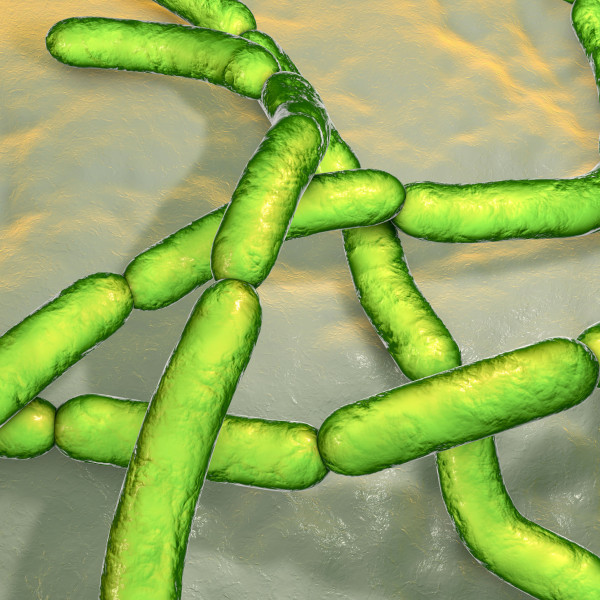
What is Bacillus anthracis?
Bacillus anthracis is a bacterium that causes anthrax. The bacterium belongs to the group of gram-positive bacteria and is a member of the Bacillaceae bacteria. With a circumference of about 1 x 4 micrometres, the anthrax pathogen is a relatively large, aerobic, immobile rod-shaped bacterium and is transmitted mainly by its terminal spores.
Who discovered the Bacillus anthracis pathogen?
The Bacillus anthracis pathogen was discovered by Aloys Pollender in 1849. Pollender was the first to identify anthrax rods in the blood of infected animals. It was not until 1876 that Robert Koch succeeded in propagating the pathogen as the first bacillus culture and identifying its importance in the transmission and development of anthrax. Koch was also able to detect the spores of the anthrax pathogen. Louis Pasteur developed the first vaccine against anthrax in 1881 and tested it in a large-scale experiment on sheep. It was not until 2002 that the genome of the Bacillus anthracis pathogen could be completely sequenced.
Anthrax as a bioweapon
During the Second World War, bombs filled with the Bacillus anthracis pathogen were dropped on Gruinard Island in Scotland. The aerosols released allowed the spores to spread, whereupon the test animals on the island died of anthrax. Spores were still detected decades later, which is why the site had to be extensively decontaminated.
After the Second World War, various states, including Russia, signed the so-called Biological Weapons Convention. Nevertheless, this did not stop Russia, or the Soviet Union at the time, from pursuing a programme of biological weapons research. In an accident in Sverdlovsk in 1979, weapons-grade spore powder was released, resulting in the deaths of dozens of people. The accident was covered up until pathologists were able to prove that the pathogen was not of natural origin. It was not until 1992 that the then Russian President Boris Yeltsin officially took a stand on the incident and promised to stop all active biological weapons programmes.
With regard to a possible international terrorist attack, press reports on this have been accumulating since the end of the 1990s. in 2001, five people died as a result of a series of attacks in the United States. They had come into contact with letters containing anthrax spores.
How is the Bacillus anthracis pathogen transmitted?
In spore form, the Bacillus anthracis pathogen can remain in the soil for decades. As soon as herbivorous mammals such as sheep, cattle or pigs ingest the pathogen through their feed, it multiplies in the animal's organism and leads to its death. Even in the animal's carcass, the Bacillus anthracis pathogen can continue to multiply and goes back into the spore stage as soon as the multiplication situation becomes unfavourable. In order to avoid transmission with the anthrax pathogen, carcasses infected with Bacillus anthracis pathogens must therefore not be buried and must be compulsorily incinerated for infection reasons, as it is now known that the spores themselves can live on for a long time in the fur and/or on the skin of the animals.
Who is particularly threatened by the Bacillus anthracis pathogen?
Anthrax epidemics are almost always associated with the processing of animal products or animal husbandry. Tanners, furriers, but also milkers and veterinarians are therefore among the occupational groups at risk from the Bacillus anthracis pathogen. Anthrax is therefore a recognised occupational disease among butchers, farmers and veterinarians. The transmission of anthrax from person to person does not usually occur.
How does an anthrax infection manifest itself?
Doctors distinguish between the following types of anthrax, according to which the possible signs of disease differ:
- Pulmonary anthrax:develops after inhalation of spore-containing dusts and/or aerosols and attempts bronchopneumonia within a few days. This is manifested by high fever, a bloody cough and hypoxia (undersupply of oxygen to the body). Bronchopneumonia is fatal after 2 to 3 days.
- Cutaneous anthrax:develops after direct skin contact with the infected material. Cutaneous anthrax manifests itself by the formation of a papule and the subsequent formation of an ulcer, which is characterised by a black scab.
- Intestinal anthrax:develops through the consumption of raw meat from infected animals and occurs rather rarely.
- Anthrax sepsis:has various clinical presentations of anthrax disease and is usually lethal due to complications via the bloodstream.
How is anthrax diagnosed?
If anthrax is suspected, the patient is tested for the presence of the Bacillus anthracis pathogen by performing a TSB broth. The pathogen presents as gram-positive in the gram stain. Characteristic of Bacillus anthracis are its irregular edges of colonies. These can appear as medusa-like spurs.
Is anthrax infection generally fatal in humans?
To become infected with anthrax, a large quantity of spores is required. In addition, the disease can be treated relatively well and successfully with penicillin. In addition, ciprofloxacin, erythromycin or tetracyclines can also be administered.However, as with other pathogens, there is also the danger that the bacterium can be genetically modified, making it potentially more dangerous.
According to section 7 of the Infection Protection Act, an acute infection with anthrax must be reported in Germany. Here, the obligation to report refers primarily to laboratories. In Switzerland, there is an obligation to report an anthrax infection according to the Epidemic Law.
How can an infection be prevented?
An anthrax infection can be prevented by taking tetracyclines and ciprofloxacin. These are taken for 60 days. In addition, antitoxins, for example in the form of monoclonal antibodies, can be prescribed. A vaccine for anthrax prophylaxis has now been approved and is recommended above all for high-risk groups and in endemic areas.
